We hope you enjoy the articles and short stories presented here, and will join Kate in her adventures for many years to come.
Upon request, you will receive an inscribed copy of Kate Tattersall Adventures in China with every donation of $10 or more plus shipping. Please use the Contact Page to provide your shipping address and we will reply with your total.
When reading 19th century diaries, literature, and magazines, one might come across something like this: “Basquine of black velvet trimmed with narrow galloon, which is edged with lace. The lappets are long and come well over the hips.” Peterson’s Magazine, 1855. Due to several requests from Victorian era enthusiasts, what follows is a list of fashion terms used from 1837 to 1901. I will not get into all obscure marketing names like the Zerlina, Maritana, and Eugenie capes, the Echarpe Orintale dress, or the Anna and Hortense bodies, as a few examples; there were thousands. As I have covered undergarments and hats in previous compositions only a few definitions will be included here. Ensuing articles will examine the complete outfits and forms of dress that made up a wealthy lady’s and gentleman’s wardrobe, a fabrics glossary, and another to catalogue hat styles. I hope the list below will provide a decent lexicon for those who wish to understand the fashion words of the 19th century. Keep in mind, the application of these terms altered decade to decade, and varied between the British Empire and America. The interesting and sometimes amusing quotes I have included with most of the descriptions can be a bit confusing and contradictory, revealing that many of the words were constantly evolving, and fashion changed with each season. There are a great deal of archives from London publishers available, but I decided to quote other sources, and included every decade of the Victorian era.
Note: Many of the words used throughout the descriptions below are explained later or in the following article. If I miss any, please let me know through the contact page.
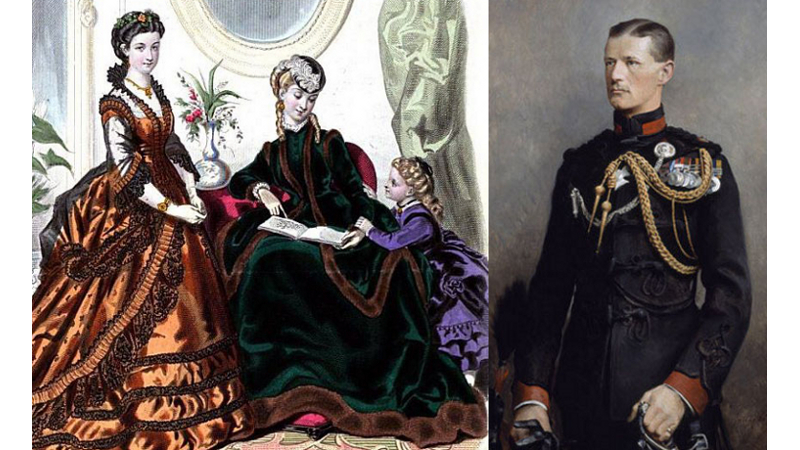
A fashion plate from 1869 probably showing aniline dyes. Lieutenant F.H.S. Roberts, VC, (1872-99) King’s Royal Rifle Corps, wearing an aiguillette. He died from his wounds after the Battle of Colenso, South Africa. His father was Field Marshal F.S. Roberts, VC.
Aiguillette is a braided cord, often with metal ends, and has been used on uniforms since the 1700s and accepted as a sign of appointment since the Napoleonic Wars (1803-15). (Aglet is the name of the metal end.) In Victorian fashion parlance, aiguillette meant any braiding of trim, usually applied when some weight was required to encourage a ribbon, lappet, or lace, to hang properly. Military aiguillettes were often worn hanging from an epaulette, and civilian uniforms copied this decoration. “Thither I drove – knocked – was let in, and demanded of a footman six feet high, with aiguillettes large and rich enough for a staff officer, whether Captain Blake was at home.” The Adventures of Captain Blake; or, My Life, by William Hamilton Maxwell, London, 1838.
Aniline dyes were the first cheaply produced synthetic dyes, allowing a boom in relatively inexpensive bright coloured clothing. Previously, dyes were made naturally from plants, animals, and minerals, and were inclined to run and fade. Aniline is an oily liquid derived from coal tar, and at first it was expensive, but when its use for industry was discovered the product started being made in huge quantities. The first aniline dye, mauveine, a deep rich purple, was created by W.H. Perkin (1838-1907) in 1856. Other bright colours followed; fuchsine (magenta), safranin (red), induline (blue), &c., always named to differentiate the dyes from their natural counterpart.
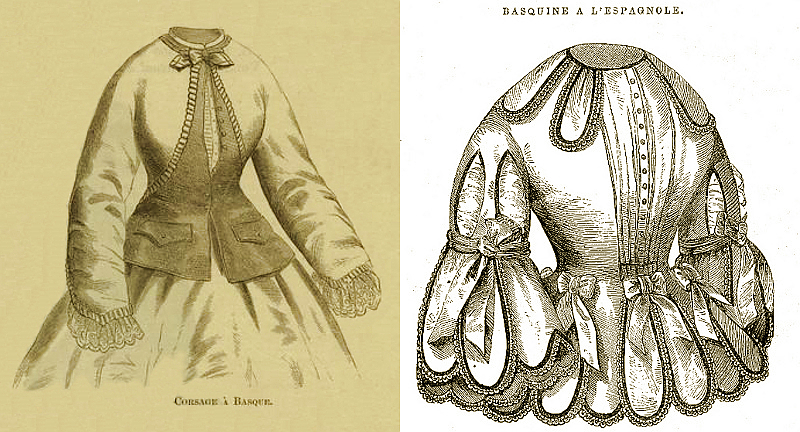
A basque from 1864, and a basquine with many lappets and bows from 1857.
Basque is a group of people inhabiting the Pyrenees of France and Spain. In the Victorian era a basque was a snug bodice, usually with extensions (skirting, peplum, lappets, &c.) that covered the hips. The word came into use with this meaning around 1850, the same time the more elegant term basquine reappeared. By the 1870s or so, basque was sometimes used when describing only the bottom portion of a bodice or jacket; those decorative frilly adornments which covered the hips. The back portion of a basque might be separately listed as the postillion. Basque-bodice was often used to label a fancy woman’s blouse, and in the later 1800s included sleeveless versions. The word was used well into the Edwardian era, but of course the styles changed annually.
Basquine was a word that meant a tight fitting corset-like under-bodice of heavy material worn in the 16th century. The Victorian’s love of Continental terms for fashion saw the word revived to mean a sort of beautiful finely crafted and extensively decorated shirt of silk or satin. This would be worn “at home” or for decidedly private strolls on the estate, and never crushed under a coat. By late in the 1850s, basquine and waist were used somewhat interchangeably for a woman’s shirt, and even named in regards to an elegantly crafted jacket or coat. The quote that follows reveals one attempt to explain different terms, but they are contradicted in the same magazine. “A new form of basque has appeared, called the basquine Boleros, from their resemblance with the corsage of the gitanos: these basquines are cut in points. I must tell you, however, that basques and basquines are not precisely the same; basques are so called when they are not cut in the same piece as the corsage, but are added; basquines are all in one piece with the body… The basquine boleros are trimmed all round with fringe, a ruche of ribbon, or a galon (galloon). The prettiest trimming for them is lace not too wide.” The Ladies’ Companion, London, 1853.
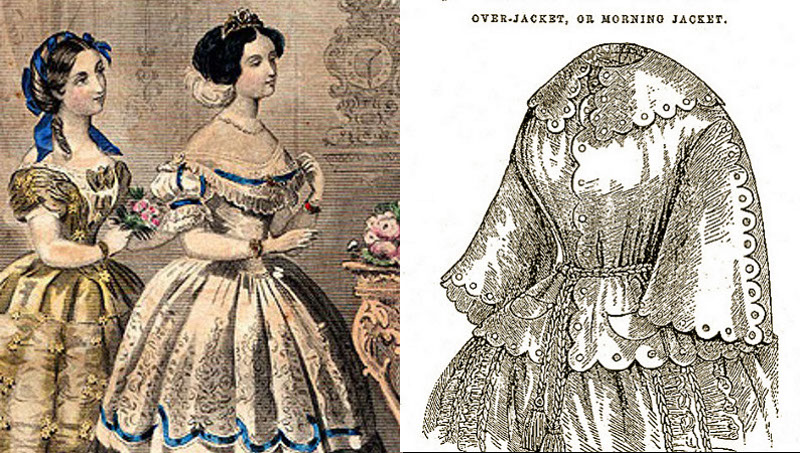
The lady on the right has a bertha on her gown, 1855. Bell sleeves with scalloped cuffs and shoulder line, 1857.
Bell sleeves were small at the armhole and wide at the elbows (short sleeves) or wrists (long sleeves). This style of sleeve became popular in the late 1840s and lasted through to the 20th century in various sizes. The tops were so narrow in the 1840s and early 1850s that they were sometimes crafted as separate pieces and tied to the bodice. With the bulky openings engageantes were worn. It could be argued that sleeves of this style with flounces were specifically called pagoda sleeves, but the terms seem interchangeable when reviewing Victorian articles. Late in the 1800s short bell sleeves for evening gowns appeared quite a bit, until straps became popular. “Bell-sleeves must be cut together and reversed, and each sleeve is cut in one piece.” Cassell’s Household Guide, London, 1869.
Berthas were a decorative piece added to a low-necked bodice, covering and wrapping the bosom and shoulders, and closed at the back with hooks and loops. The term came into use around 1835, named after Bertha (mother of Charlemagne), the 8th century Frankish queen, who was famed for her modesty. Berthas were usually crafted on a stiff net base with various decorations and all the edges were finished for a neat appearance. It was simply sewn to the outside of the neckline of the bodice with a running stitch, serving as a modesty piece. By the 1860s, the built in pelerines of bodices were sometimes listed as berthas. “Bodice of white pleated muslin, trimmed with ruching of coloured ribbon and silk buttons, simulating a pointed bertha on the front, and fastened on each shoulder by a bow or wide ribbon, with long ends, terminated by aiguillettes.” The Young Englishwomen, London, 1867.
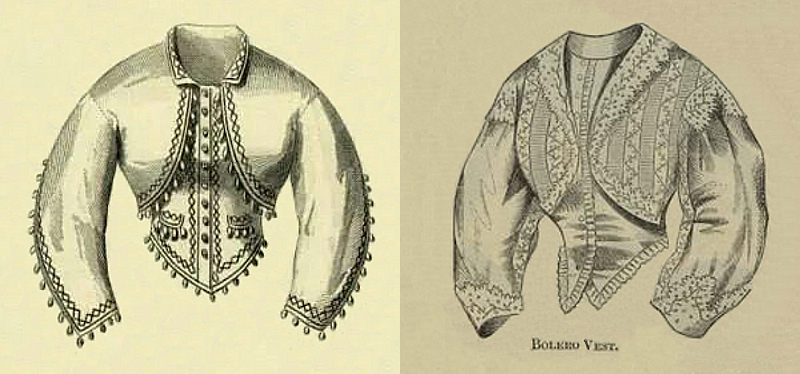
It would be nice to see these in colour. A bolero with matching bodice, and a bolero vest, both from 1864.
Bolero: A small tailored cropped jacket of expensive material worn open at the front. The “bolero” is a lively Spanish dance, in which the performers wore small embroidered jackets. In the 1850s bolero denoted a Spanish fashion style applied to bodices. By the 1860s the jacket appeared as a fashion for wealthy ladies. “This jacket forms one of the newest designs for the present season. It is usually of fine cloth, lined with silk which contrasts with it. The ornaments have the appearance of revers, and should therefore be of the same colour as the lining; but the braid pattern on it must be the same colour as the cloth. The edges of these revers are bound with a narrow ribbon, either of the two colours, or the same as the braid; for instance, if the jacket is of blue, violet, or scarlet cloth, the lining and the revers should be of black silk, ornamented with a coloured braid, the buttons and binding-ribbon being black. If’ however, the jacket is black, a white or coloured lining and revers is required, with black braid and buttons; the binding-ribbon being a mixture of the two colours.” Arthur’s Home Magazine, Philadelphia, 1864.
Bosom friend referred to an undergarment rather like a bib, shaped to cover the breasts, made of knit wool, flannel, or fur, providing warmth and volume. Of course, bosom friend also was used as a term of intimacy, in regards to a particularly dear friend; one you would hold in the small of your heart. “Some persons do not hollow out bosom friends, but knit them square or oblong.” The Workwoman’s Guide, London, 1840.
Bouillonné was the fancy term for a ruffle, like ruching, when a strip of cloth, ribbon, lace, &c., is gathered along one edge and tacked onto a gown or blouse as trimming. It is a French word, of course, and translates as bubbled, as though the fabric is frothing along a seam or hem.
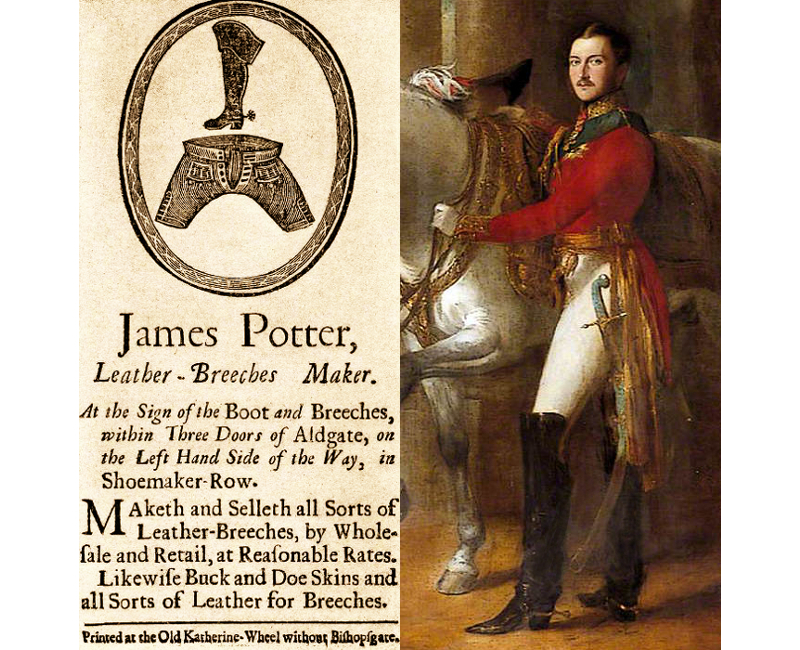
An old breeches ad, and Prince Albert in uniform, with breeches and military jackboots.
Breeches were any type of riding pants, often worn with braces or belt (or both), usually ending a bit below the knees with laces, buttons, or buckles, to allow a snug fit. There are countless examples and descriptions, varying from tight to baggy and of all materials. The best were made of soft leather, and crafted to fit perfectly. “The present generation little know, that when their fathers were born the art of breech-making was not confounded with the general cutting-out and trimming business of the tailor. It was a separate business, and the leather-breeches maker, in particular, was a man of considerable skill and importance.” Blackwood’s Magazine, Edinburgh, 1840
Bretelles referred to a pair of ornamental suspender-like shoulder strap accessories that appeared as a fashion term around 1850. The straps were decorative, crafted of quality wool or silk, trimmed with lace, buckles, bows, &c., to set off a particular outfit or provide variety to a lady’s wardrobe. The straps were worn over a bodice then tied and tucked into a skirt or attached to a matching belt. Of note, the word was used interchangeably with the masculine form of pantaloon suspenders; plain elasticated straps with adjustable buckles for men. (These soon became known as braces and suspenders.) “Bretelles or pantaloon suspenders, as made with each pair of the front button hole straps united to or springing from their back or shoulder strap.” Chronological and Descriptive Index of Patents Applied for and Patents Granted, London 1872.
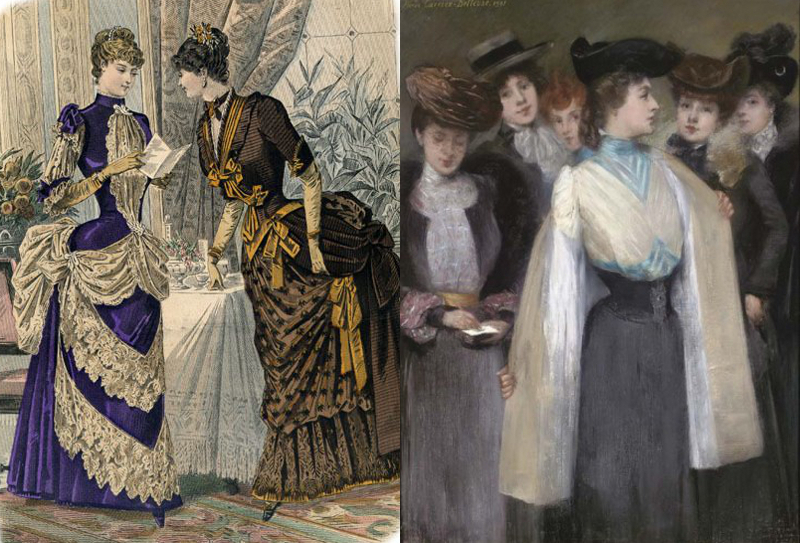
Ladies in bustle gowns with extravagant drapery and trim, 1880s, and a corselet skirt, 1895.
Bustle may have evolved from the rustling sound of a silk skirt as a buttocks pad bounced when a lady walked, but the word existed before then meaning “to move or act with a great show of energy.” In the 1830s bustles were quilted pads or pillows worn with a waist strap. The various cages worn by the 1850s made this form of padding less popular, but still worn by some women with their petticoats. In the 1860s, the silhouette shifted the skirt to the rear, and by late in that decade a cut down crinoline developed, known as the crinolette, which in turn became known as the bustles of the late Victorian era. “’My dear,’ her friend replied, ‘it must be the effect of your bustle. What do you stuff it with?’ ‘Hair – horse-hair,’ was the reply.” Irish Penny Journal, Dublin, 1840-41. “Braided wire bustles and bust forms give style with coolness, style with lightness, style with comfort, style with cleanliness.” Parisian Illustrated Review, New York, 1898.
Calèche or calash is usually thought of as a carriage with a folding roof, but it became a fashion term in the late 1700s in regards to a hood, crafted with hoops to keep it from crushing a lady’s hair. By the early to mid 1800s, calèche was a stylish name for any fancy hood, or a bonnet with ribs. “It was pleasant to see the old lady in her green silk caleche, with a basket on her arm, filled with medicines and old linen…” Echoes of a Belle, by Ben Shadow, New York, 1853.
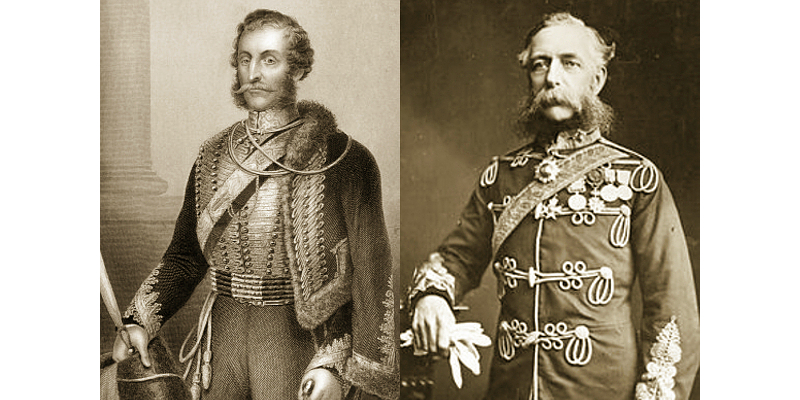
Lord Cardigan depicted in the old style dolman and pelisse of the 11th Hussars, and in an odd version of the new “Austrian” style dolman adopted after the Crimean War. The latter dolmans usually had six or seven buttons and knots on the front. All these styles were copied in civilian fashion, subtly for men, lavishly for women.
Cardigan came into use after the Crimean War, named after J.T. Brudnell, 7th Earl of Cardigan (1797-1868), who led the charge of the Light Brigade at the Battle of Balaclava, (25 Oct 1854). The man was considered a hero, but has since been exposed as an arrogant and poor commander who didn’t care for his men. In the cold of the Crimean winter, Brudell wore a tight-fitting collarless knit wool shirt with a buttoned front under his dolman. Due to his fame, what had been known as winter under-shirts changed to cardigans, and started to be worn over the shirt.
Corsage meant the body of a gown, dress, or shirt, taken from the Old French word cors. The corsage of a bodice referred to the main fabric used, not including all the tacked on trim. “White satin robe, the corsage very low, and deeply pointed with a deep bertha of Brussels lace, which quite covers the short tight sleeve.” The New Monthly Belle Assemblée, London, 1845.
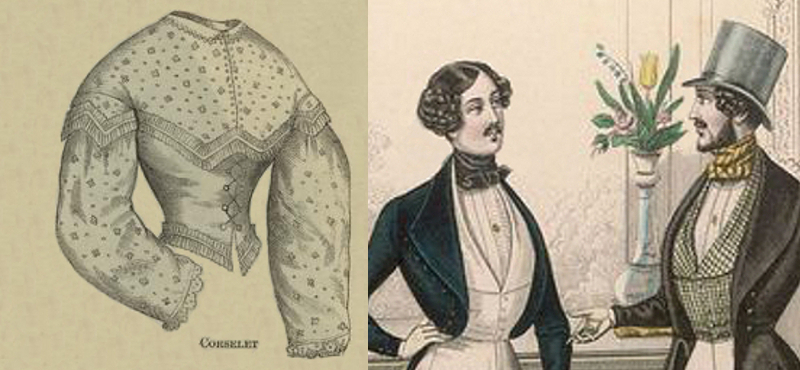
A corselet and blouse, 1864, and gentlemen in cravats and waistcoats, 1837. The man on the left wears a tailcoat, a cutaway style of jacket, and the man on the right wears a common frock coat.
Corselet/corselette originally referred to a suit of light half armour in the 16th century, and was used as a fashion term starting in the 1860s as a outer garment for girls that wrapped their midriffs, and was constructed similarly to the adult Swiss waists, so the words became interchangeable. Throughout the 1880s and 90s the term was used frequently in adult fashion as part of outfits to define a lady’s waist. Corselets and corselet belts were similar, and looked something like an under-bust corset worn on the outside of a bodice. The corselets covered from lower-ribcage to hips, while the corselet belts might only go from waist to hips. These garment were boned and pointed at the front like corsets, but didn’t have a metal busk built in, and usually laced or buttoned at the back. They were made as accent pieces to draw in a blouse and cover the top of a shirt, and also crafted as part of a dress. Corslets appeared in the 1860s as part of evening and ball gowns, fell out of fashion, then became very popular in the 1880s and 90s with day-wear. The look was built in to evening gowns, the same way pelerines had evolved earlier. These terms were interchangeable with Swiss waists, or Swiss waist-bands, and Swiss belts. “The fronts open to show a laced silk corselet, which defines the waist, and above it is a loose front, also of brown silk.” Truth, USA, 1886.
Cravats (or neckcloths) were long strips of cloth (silk, linen, cotton, &c.) that were wrapped around the neck, then tied in any one of many different knots, forming a sort of flat jabot, and were the forerunner of the modern tie. They were popular in the 16 and 1700s, and the first half of the 1800s, worn with baggy shirts over high soft collars, but with fitted shirts and neat collars cravats shrank in size and became bows and ties. “Could the history of the cravat be told in a hundred printed pages, and with only five illustrative prints?” All The Year Round, by Charles Dickens, London, 1860.
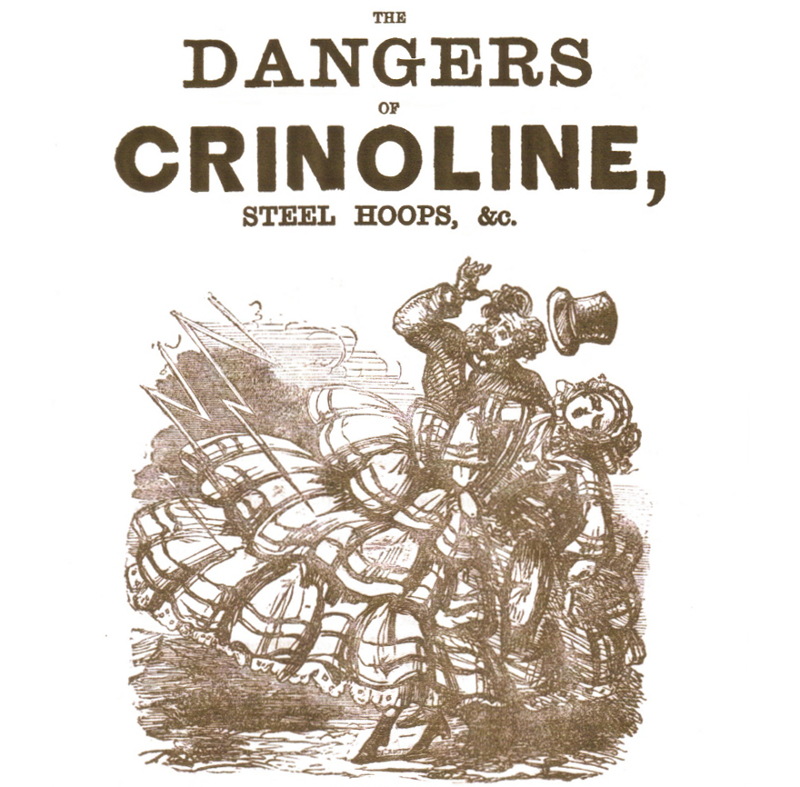
“The Dangers of Crinoline, steel hoops, &c. shown in the fearful account of a lady of title nearly burnt to death, and who afterwards retired into a convent; also, a wealthy farmer’s daughter in Yorkshire, who was struck by lightning, and lost the use of her limbs; together with many other startling and interesting narratives in connection with crinoline, steel hoops, &c. Price one penny. London 1858.”
Crinolette was a term used in the late 1860s as the crinoline fashion craze faded. It was a series of metal spring hoops held together with cloth strips and worn at the back, serving as a bustle. The word remained in the fashion lexicon through the 1870s and 80s. “Amongst these articles of a lady’s wardrobe there are as follows: The bellforme crinolette, bijou train, straw-plait crinolette, Empress resilient, corymbus bustle, Paris puffed bustle, lattice panier crinolette, half covered crinolette, bijou jupon, rouleau panier, volute bustle, &c.” East London Industries, by W. Glenny Crory, London 1876.
Crinoline originally referred to a stiff horsehair fabric popular by the 1840s for petticoats and flounces, providing volume under skirts. As the bell and dome shaped skirts became more popular the “cage crinoline” of hoops and cloth strips evolved and replaced the layers of petticoats. (This cage somewhat echoed the farthingales of Elizabethan times.) By the late 1850s the word crinoline was understood as anything worn under a skirt to achieve the fashionable silhouette, including the new cages of light wood or steel hoop skirts, and by the early 1860s inexpensive versions were available for all women. There were also crinolines made for arms, to hold out the enormous gigot sleeves. “Many of the male sex who are unacquainted with the mysteries of ladies’ attire, have asked of what crinoline consists. For their enlightenment, therefore, we explain that one of the materials worn under this name, consists chiefly of horse-hair, with puffs inserted, and, at intervals, hoops of steel or cane. Another variety comprises a sort of skeleton framework of steel or wooden hoops, without any material whatever.” The Dangers of Crinoline, Steel Hoops, &c., London, 1858.
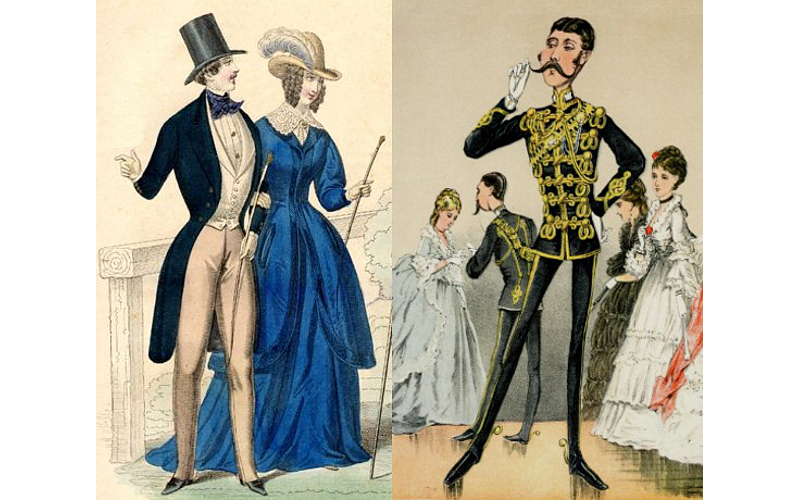
To the left. the gentleman wears a cutaway morning jacket/tailcoat, the lady wears a riding habit, 1843. On the right, a satire of the 10th Royal Hussars attending a ball in their dolmans, probably late 1850s (judged by the gowns) when this Austrian style tunic was adopted.
Cutaway, as applied to a jacket, meant the front only drew near or met below the neck, then swooped or angled away. Bolero jackets would be crafted to round back nicely to a peplum. Men’s morning coats and evening dress jackets (or other formal coats) would have the bottom portion of the front cut away from the waist so as to curve or slope to the tails at the back. The lining could be of a bright coloured silk, flashing on the tails as a man walked. “Underneath his greatcoat he wore a green cutaway jacket with brass buttons, such as may be often seen in the hunting-field; and his warm vest was of broad plaid, and looked comfortably bucolical.” Temple Bar: A London Magazine for Town and Country Readers, 1865.
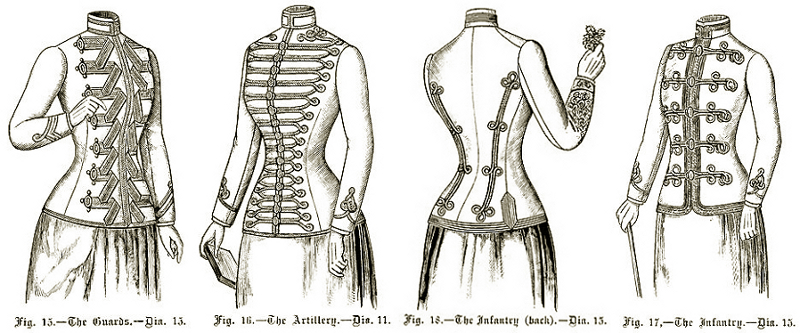
Feminine dolman styles, 1890, The Guards, The Artillery, and The Infantry.
Dolman came from the Turkish word dolaman, which means robe, and was a long loose garment. By the Napoleonic Wars it was a military tunic, particularly for cavalry regiments, worn over a shirt. It was the day-to-day jacket, to which might be added a pelisse, a rain cape, or a greatcoat. Copying military fashion came and went throughout the Victorian era, but due to the flag-waving of the Empire and its imperialism, martial cues can be spotted every year to some degree, in men and women’s clothing. For women, the dolman was a jacket crafted tight in the body with large cone-shaped sleeves attaching at low narrow armholes, and often decorated in military galloon, soutache, tassels, &c. These coats, called dolmans, were particularly popular during the Crimean War and American Civil War, and by the 1870s the word grew interchangeable with mantles, sometimes dolman-mantles. However, by the late 1880s and through the 1890s, dolmans were tailored much more like a military tunic, with tight-fitting body and sleeves, similar to spencer jackets. Interestingly, nowadays, the dolman sleeve is of an opposite style of the 1850s to 70s, being tight at the wrist and with enormous armholes, extending from shoulder to waistline.
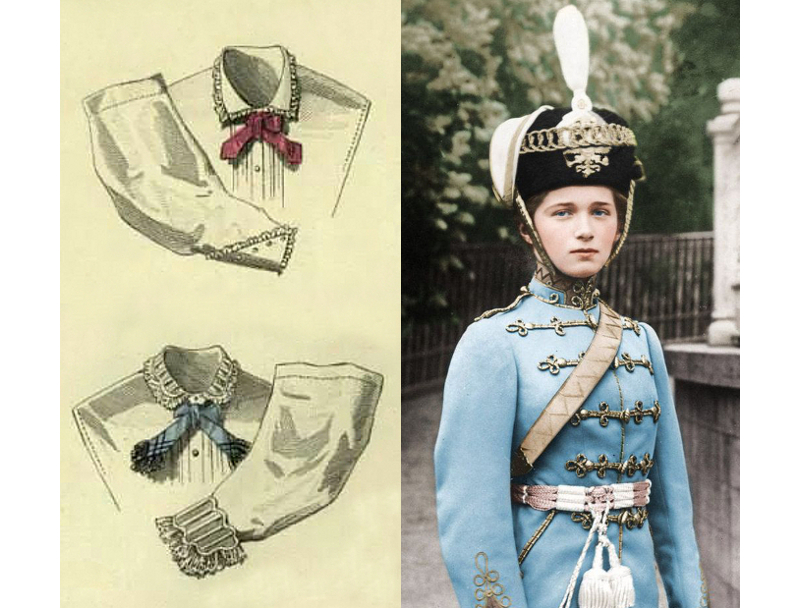
Bodies with matching engageantes, 1864, and Grand Duchess Olga of Russia in her Hussar uniform, showing galloon epaulettes and trim.
Engageantes was the fancy fashion term for under sleeves. Due to the popularity of bell-shaped sleeves with large open cuffs, a covering was necessary. Engageantes were made of various fabrics and held above the elbow by elastic, or were tacked into the sleeves of bodices and removed for laundering. “… the ample robe starting from the neck, plaited in the back like an abbe’s cloak, and floating loosely down to the feet, the arms emerging flowerlike from short sleeves filled with engageantes of lace.” Wimples and Crisping Pins, by Theodore Child, 1894.
Epaulettes were any form of ornamental shoulder piece. During the sloped shoulder fashion periods women did not favour anything that accentuated their shoulders. Ruffles and tassels at the top of sleeves were used, then bows on shoulders were seen occasionally in the late 1860s. While shirts had puffed shoulders on and off, jackets with similar styling grew in popularity in the late 1800s and sometimes featured epaulettes. Men’s jackets for countryside pursuits often had epaulettes, as did children’s clothes. “Red coats and worsted epaulettes, and flummery, were all very well in their way; but the disposal of our good cargo of slaves would, he knew by experience, go much further to fill the coffers…” The Cabin Boy’s Story, New York, 1854.
Eton jacket, see Spencer jacket (next article).
Fichu referred to a gauzy frilly type of large collar or small shawl and was a carry-over from the 18th century. The word was a French verb for ‘carelessly thrown on’ and evolved into an English noun. Throughout the Victorian era fichus came and went in various forms as a fashion accessory. “The Fichus and Fichu-Mantelettes are becoming more and more fashionable, and are made in a great variety of styles.” The World of Fashion, A Journal of the Courts of London and Paris, London, Paris, New York, 1867.
Field boots (also called shooting boots) among the wealthy Victorians were usually buff or brown leather knee-high boots, with laces/buckles to adjust the fit, good for walking or riding. For agricultural labourers, field boots referred to sturdy leather ankle boots with nailed soles. Officers had dress boots and field boots (black and brown), which can be found listed in personal accounts of campaigns. Starting in the 1870s, porpoise hide and oil was used for waterproof field boots, and considered ideal for those travelling to remote corners of the Empire. “A pair of soft leather slippers, three or four extra pairs of porpoise-hide laces, a tin of porpoise-oil for dressing “Field Boots” (if made of porpoise leather), will complete this portion of the outfit.” On Duty Under a Tropical Sun, by S.L. Hunt and A.S. Kenny, London, 1882. See Boots For An Adventuress; what did Kate Tattersall wear?
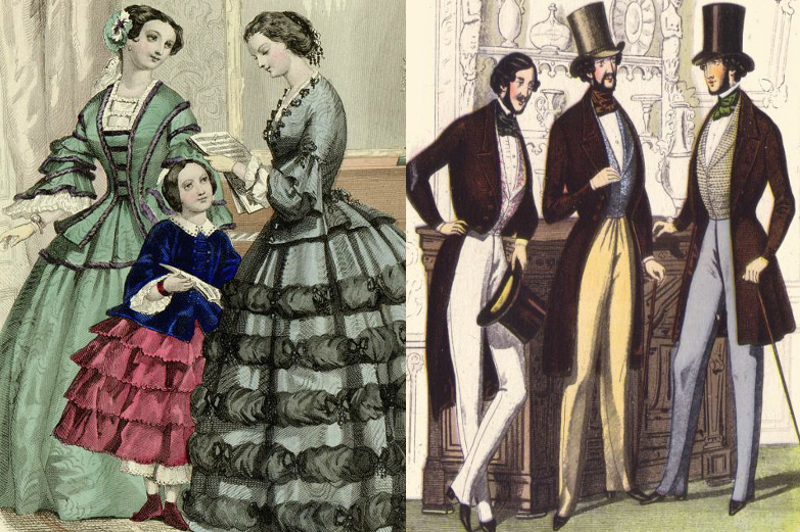
The lady on the left has flounced pagoda sleeves. The girl wears a skirt with four flounces, her pantalets visible below. They all wear white lace engageantes, and peplum bodices, 1855. Men in day wear, the two on the right wear frock coats, the other a cutaway tailcoat. 1840. Note the kidskin gloves in both fashion plates.
Flounce, in 1800s fashion parlance, was a strip of cloth, sometimes of lace, embroidered or trimmed, gathered and attached at the top under overlapping flounces, creating the appearance of multiple layers of the same fabric making up a skirt and sometimes the sleeves (and appearing very much like the pagoda roofs of China). Layers of flounces were also attached to petticoats to increase volume.
Frock usually referred to a man’s fitted coat, single or double-breasted, tight at the waist, about mid-thigh to knee-length. Most quotes will be “frock coat” but frock also appears by itself sometimes. However, frock was also used in a feminine form, to mean a dress, generally one that was complete with bodice and skirt together. “He was sensible of a better personal effect than the men in frock-coats and cut-aways were making, and he perceived with self-satisfaction that his evening dress was of a better style than that of the others who wore it; at least no one else carried a crush hat.” Indian Summer, by W.D. Howells, 1886.
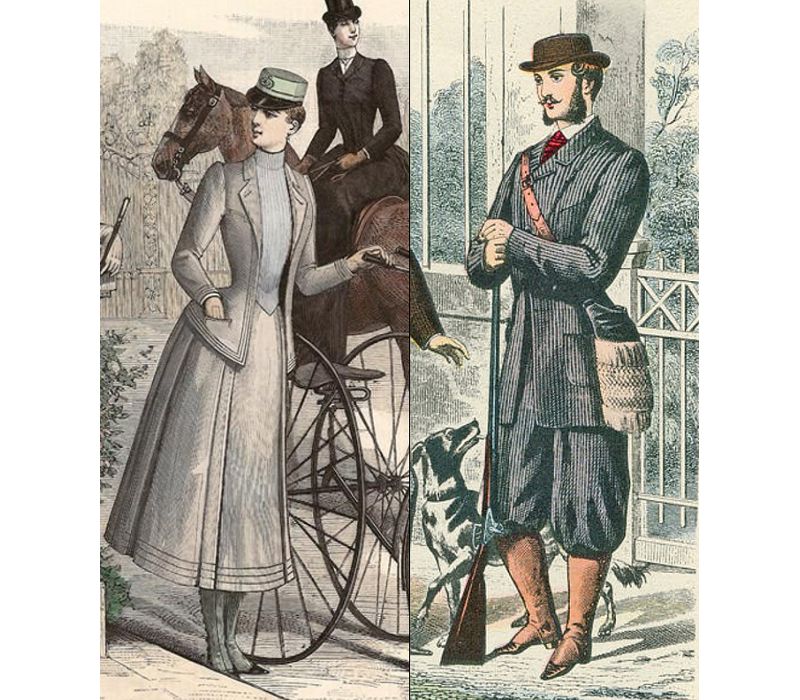
On the left a lovely late Victorian cycling gown with gaiters. On the right a hunting suit with gaiters, 1861.
Gaiters: A leg covering of various lengths (most common knee to ankle) made of leather, wool, cotton, &c., all of a heavyweight or thick weave, worn for protection and warmth with low boots or shoes. These are most commonly thought of as labourer attire, but wealthy gentlemen wore them for countryside pursuits, and ladies wore them for inclement weather and county rambles, and by the late 1800s ladies had them made to match their various athletic outfits. “Women’s silk, satin, and kid, button and lace gaiters of generally good material and workmanship. (On display from Italy.)” Reports on the Philadelphia International Exhibition, London, 1876. See spatterdashes (next article) for more.
Galloon is a rope-like braid, usually of worsted wool or silk, sometimes with gold or silver thread, used for trimming. This decorative rope was sewn on uniforms, civilian clothes, pillows, furniture, &c., throughout the 1800s. It was particularly popular for uniforms because it provided some protection against sabre slashes, then copied by ladies who wanted to emulate the military styles. As ropes and braids were originally handmade, early Victorian uniforms featured galloon and embroidery. When machines started being used to make flat braids, much of the galloon was replaced by soutache, which sat flat. Where expensive embroidery had been before, like sleeve cuffs, soutache could be sewn on instead. By the late 1800s, most military dress uniforms were covered in soutache, but still called galloon. “Under-waist of raw silk, trimmed round the neck and down the front with a strip of cherry silk, edged with gold galloon and narrow black lace.” Harper’s Bazaar, New York, 1867.
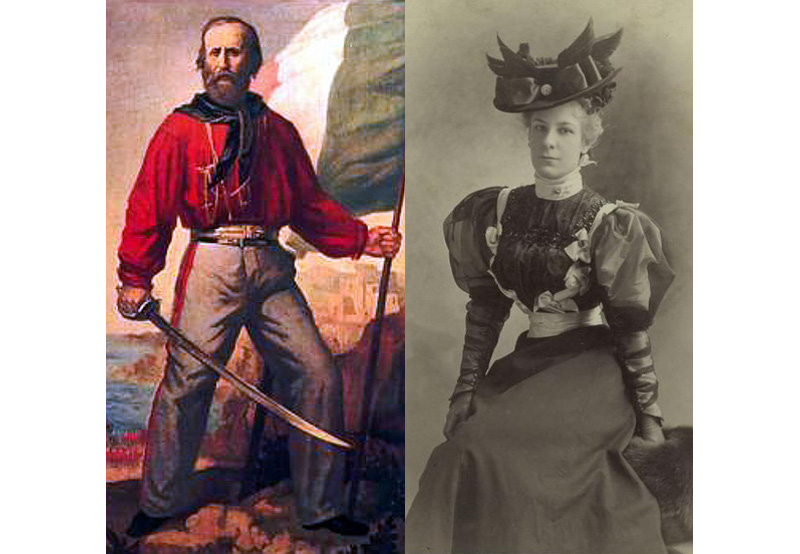
Garibaldi in his famous red shirt from around 1860, and a lady with gigot sleeves, corselet belt, and a muff, 1890s.
Garibaldi shirt/Camicia rossa was a red wool shirt named after the Italian general and politician Giuseppe Garibaldi (1807-82) which became popular in 1860, and evolved into the modern women’s blouse. Legend has him taking the shirts from slaughterhouse workers in Buenos Aries, or New York firemen, perhaps both. It was worn by men and women, and produced in every colour and different fabrics. “Those who expect to see something of the austerities of convent life, will be surprised to find a very pretty young lady in a dark straw hat and Garibaldi shirt, standing on a ladder to cut grapes in a greenhouse.” London Society, 1862.
Gigot sleeves, or puff sleeves, came in and out of fashion in various forms throughout the Victorian era. Gigot was the name commonly used in the first half of the 1800s, with puff appearing more frequently as the decades wore on. A gigot is a leg of lamb or mutton, and the sleeves resembled that shape. Some gigots were quite small, others enormous, but all with a tight closing, whether it be from the elbow to wrist, or just a thin cuff. On bodices where the gigots needed to be full and round, insertions were worn. This had been popular during the Elizabethan era, and the stuffing called bombast. “The English are likely to be the fashion in Paris this winter. They went out with gigot sleeves; they come in with whatever fashion it may please the goodness of the Mode to invent.” Littell’s Living Age, Boston, 1845.
Gloves were worn most of the time by those who could afford them. Kidskin (leather made from the hide of a young goat) was used for the best and softest gloves. Usually in fashion prints the subjects will be wearing tan or off white gloves, which would be kidskin. For evening dress and formal occasions, the gloves were white, and could be made of silk, thin felt, bleached kidskin, &c., depending on the event.
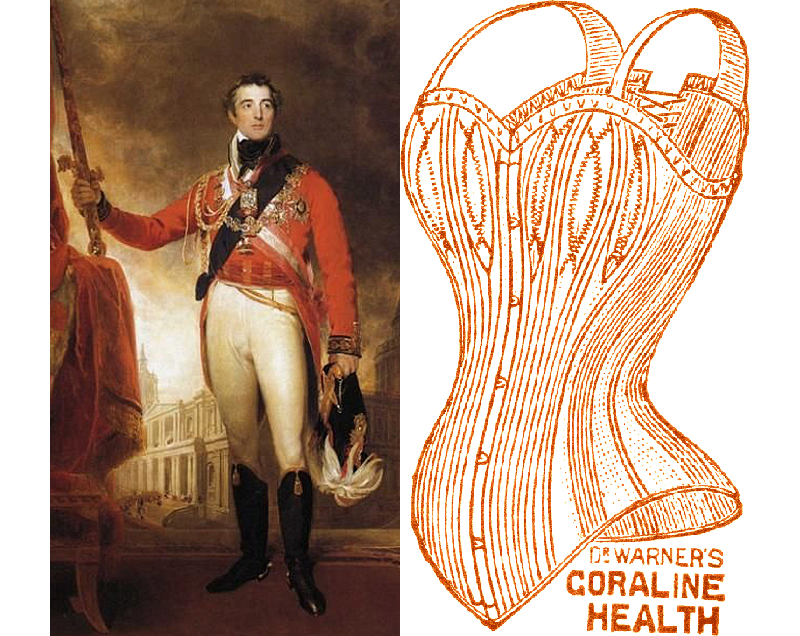
Duke of Wellington by Sir Thomas Lawrence, depicting the great soldier (ironically) in Hessian boots, an aiguillette hangs from his right epaulette, and a late Victorian drawing of Dr. Warner’s health corset, highlighting the coraline fabric.
Health corset often meant the famous Dr. Warner’s “Health” Corset, designed in 1873, made of flexible Coraline, a product of the fibres of the Mexican Ixtle plant, but there were “health corsets” marketed before Dr. Warner (McGee’s, Foy’s, Eureka, &c.). Within a few years, health corsets were produced by several manufacturers, and all were less constricting than the traditional corsets, some only supporting and covering the bosom and ribcage. Along with the nonchalant corset, these innovations could be considered the early sports bras. Many argued that there was no such thing as a healthy corset. “… had devised a corset which should relieve, set off, and support the bust without compressing it or lessening in any degree the expansive power of the lungs. She called it her ‘Health Corset’ and it appeared to be worthy of the name.” Hall’s Journal of Health, New York, 1873.
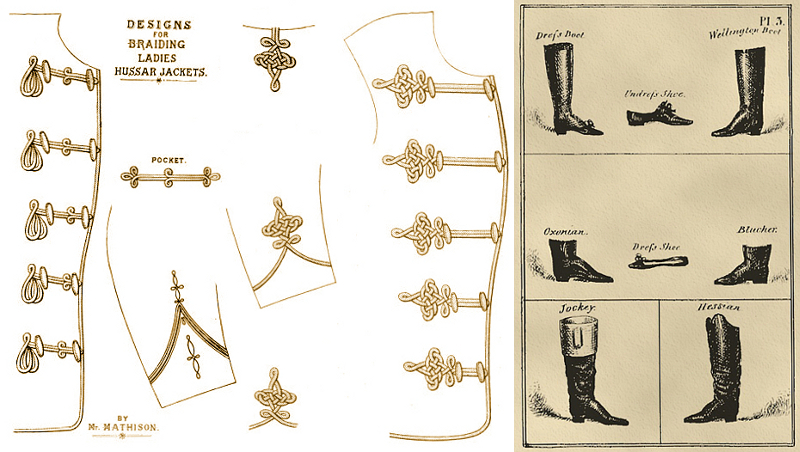
Hussar dolman braiding, featuring galloon, soutache, and perhaps Hercules braid on the lower cuff, 1885, and footwear from the early 1800s, from top left: dress boot, undress shoe, Wellington boot, Oxonian, dress shoe, Blucher, jockey, and Hessian.
Hercules braid is a wide flat weave, popular for edging on hems. It came into use during the late 1860s, produced by machine, in all colours and varying widths. “Gilt braids, silver and bronze soutache, are also mixed with black or dark-colored braid in their trimmings, and a great deal of Hercules braid, an inch or more in width, is used for trimming cloth garments of all kinds.” Godey’s Lady’s Book, Philadelphia, 1883.
Hessian boots, from Hesse (an independent duchy of Germany), referred to a style of boot that became popular in the 18th century and copied by the various cavalries of the Napoleonic Wars. This upper mid-calf leather boot with galloon trim and tassel decorations at the opening of the scalloped shaft was worn by officers, troopers, and civilians alike. “I used to wish myself a centipede, to wear fifty pairs of Hessians at a time.” George Cruikshank’s Omnibus, London, 1842.
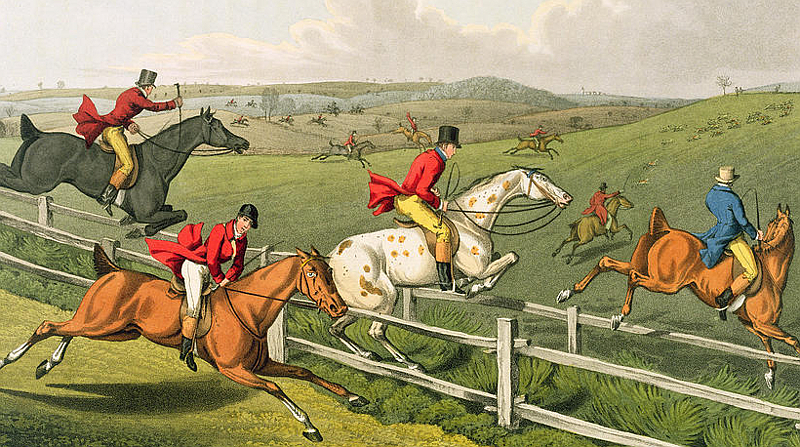
Fox Hunting, by Henry Thomas Alken (1785-1851), most wearing pinks, all in breeches and top boots. Interestingly, the individual in the foreground appears to be female. I included a quote about a lady wearing such an outfit in my article about Victorian women and trousers.
Hunting boots (for riding and fox hunts) during most of the 19th century usually meant knee-high leather boots of black with the top portion of the the shaft a natural brown, emulating the look of previous centuries when thigh-high boots were folded down, also known as top boots. As Victorian society formed and grew more strict late in the 1800s, these boots sometimes fell out of favour, all black boots (dress boots) considered best for fox hunts, which had become quite formal affairs. Fox hunters who opted for jack boots were in all black footwear (see jack boots). It was observed that the “tops” colour and length changed season to season, but the rest of the boots were always black, and should not wrinkle. Anything of brown leather, or with laces or buckles, were field boots, made for expeditions, polo, shooting, &c. “A profound hunting-boot truth, no man with a pair of fat calves can ever look well in a top-boot.” The Book of the Horse, London, Paris & Melbourne, 1892.
Jabots appeared around 1600 with the Baroque period and were worn by both sexes, and were common as part of gentlemen attire through to the 1840s, but went out of fashion only to be reinvented by the ladies in various forms of decorative bursts including lace and ruffles. Jabots started to be an expected part of a feminine bodice, a component of the decorations. Late in the 1800s, a jabot could be listed as a decoration at the side of a skirt, or wherever on an outfit. Of course, jabots were always included in any fancy dress party costume, and worn with judges’ attire and other formal robes.
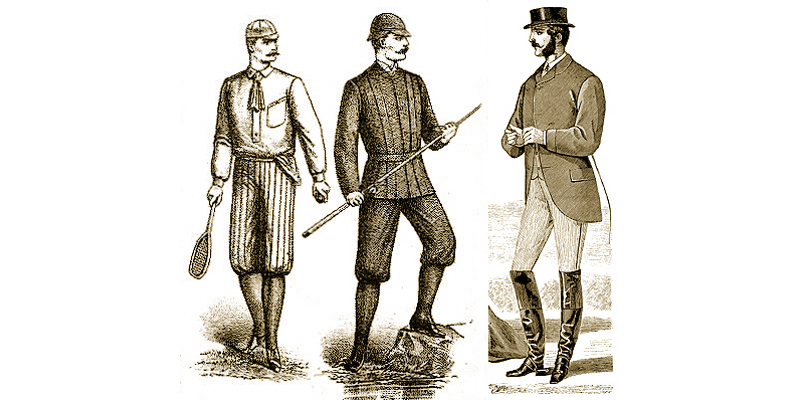
Sporting fellows; a tennis player and angler in knickerbockers, 1888, and a gentleman in hacking attire with civilian jackboots, 1868.
Jackboots was the name given to cavalry boots that went above the knees, and were reinforced with metal sewn between the leather and linings to protect the officers and troopers from sabre cuts and bayonet thrusts. Throughout the 1800s, civilians wore similar boots for mounted sports and fashion, although their boots didn’t have the reinforcements, and sometimes included elastic at the sides and behind the knees for a snug, neat, and comfortable fit. They were listed available for order at the National Exhibition, 1851. Art and photos show men in jackboots, but women would have worn them under skirts. “… the expenses attending the use of Warren’s Blacking in four regiments alone, are 9733₤. 6s. 8d. per annum, and that a great part of this expense is occasioned by the jack-boots of the Horse Guards.” Warreniana, with Notes, Critical and Explanatory, Boston, 1851.
Jersey in early to mid Victorian parlance usually meant a fine wool that had been worked with a Jersey-comb and, of course, originated on the Jersey Isles. Tops knitted of this wool were worn by the Channel Islanders and, famously, by the fishermen. As a knitted cloth the name Jersey goes back to the late 1500s. In the late 1800s Jersey wool is often listed for stockings as well, and the word “jersey” started being used to indicate a warm waist or top. “Even in warm weather a thin merino or silk jersey should be worn under the white shirt; a stouter merino, or, if the chest is delicate, a lamb’s-wool jersey should be worn under the winter shirt.” Household Words, Charles Dickens, 1885.
Jumper usually referred to a rough cotton smock or loose jacket worn by labourers, maids, sailors, &c., to protect their other clothes. It is thought the word evolved from jupe, French for skirt, because the garment was often crafted long, hanging to the knees. It could be sleeveless, and it is this form that many people think of it as a dress worn over a blouse, but this is post Victorian, as is jumper meaning jersey or sweater.
Knickerbockers was an word born in America, and applied to the Dutch settlers in New York. Washington Irving (1783-1859) wrote History of New York in 1809, and used a fictitious (nom de plume) name: Diedrich Knickerbocker. During that era Dutchmen wore loose-fitting short trousers gathered at the knee, so the name stuck to the distinctive garment. It was a common name for any baggy pants that ended below the knee by about 1860, usually crafted for sport (like shooting, mountaineering, cycling, &c.). These should not be confused with breeches, which were for equestrian pursuits, and tailored to fit snug. Women started having cycling suits made in the late 1800s, and they wore knickerbockers too. Drawers were crafted similarly, and received the name knickers, starting around 1870. “Drawers are invariably short, only reaching below the knee. If not gathered in as knickerbockers they are wide, and flannel knickers are worn under them.” The Bazaar Exchange and Mart, London, 1878.
Lappet was a name for any small hanging flap or piece of lace, &c., such as one dangling from a headdress or a seam or hem of a shirt or jacket. “To form the lappets, employ both the ends of the crochet border; 10 inches are needed for each lappet; the remaining part of the border is meant to go round the neck for the collar.” The Young Englishwoman, London, 1869.
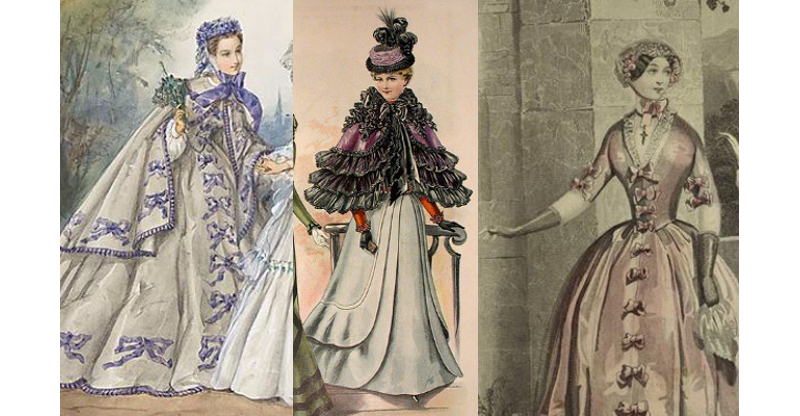
From left to right; a mantle made to match her dress, 1862, a mantlet and hat combination, 1898, and a lady wearing mittens, 1849.
Manteau is French for mantle, meaning a cloak, and a word used by the wealthy Victorians who were often taught French, and preferred Parisian terms of fashion.
Mantelet/mantelette, or short cloak, is a feminine term for mantle, and taken from the Old French word mantel. It is typical of the Victorians to use words like this to sound French and elegant. The quote that follows is a good example of how different words were used for the same item of clothing. (Pelisses are covered in the next article.) “The new mantelets are very elegant, and show off a fine figure; they are called pelisse, pronounced p’lisse.” The Ladies’ Companion, London, 1853.
Mantle was a name applied to a loose, originally sleeveless, cloak or cape. It was a very old word, coming from Latin (mantellum), Old High German (mantal), and Old French (mantel), all meaning cloak. By the 1850s sleeves were sometimes added. “… mantles of that kind… plaided in black and brown, or dark blue and grey are a good deal in vogue, and likely we think to be more so; they are trimmed very complete, with a round pelerine of a moderate size, and a small hood; the latter, very open and displaying the lining, which is always composed of satin, and in either blue of various shades, oiseau, or light green; there are no sleeves, but the armholes and pelerine are ornamented with fancy silk trimming.” The Ladies’ Cabinet of Fashion, Music & Romance, London, 1840.
Mitts/mittens, along with being knit hand coverings for cold weather, also referred to a type of fingerless gloves worn with evening dress and ball gowns. Early in Victoria’s reign, they were quite short, the best crafted of silk gauze, with thin ribbon trim. The style changed to longer and longer lengths, and started to include opaque fabrics, until sometime in the 1860s when gloves replaced them in many circumstances, but mitts continued to be worn, as were similarly constructed cuffs that were more like engageantes, after that fashion trend had ended. “Carrier, Henry & Sons, Mount St, Nottingham, manufacturers of plain and fancy cotton and merino hosiery, gloves, mohair, silk and spun silk mitts, cuffs &c., lace &c., suitable for home and export.” The Trades’ Guide for Midland Counties, and Universal Buyers’ Guide, Birmingham, 1879.
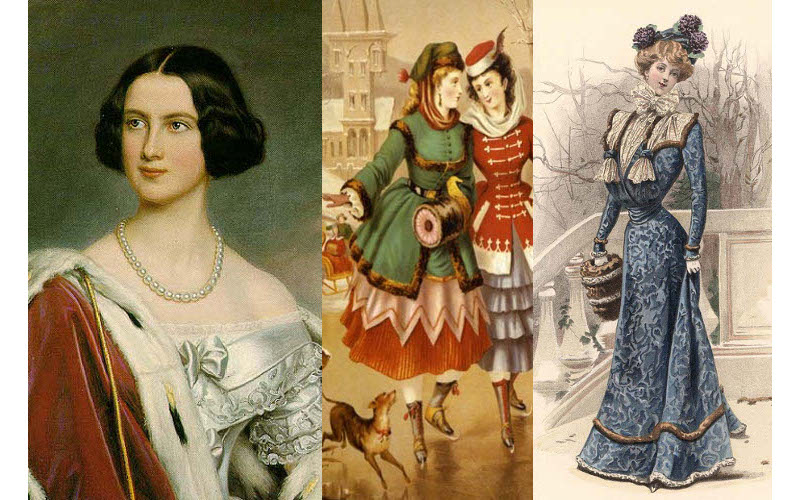
Marie of Prussia, Queen of Bavaria, has a lace modesty piece along the top of her silk gown, 1842. One of the girls skating carries a muff, 1860s, and an elegant lady with a muff, 1899.
Modesty pieces (also known as tuckers) were strips of material added to the collar of bodices, chemise, stays, or corset, to hide more flesh. A low cut breast-line could be raised with a strip of gauze or lace, and still look decorative and alluring. Berthas were modesty pieces taken a further step, and any sort of material or undergarment that covered more flesh than a bodice originally intended could be called a modesty piece. “A narrow lace which runs along the upper part of the stays before, being part of the tucker, is called the modesty-piece.” The Imperial Dictionary, London, 1883.
Muffs were thick tubular hand warmers, usually covered with fur. Muffs often held internal compartments allowing the items to serve as handbags. A lady would wear gloves, which would probably be crafted of kidskin, and use her muff for further insulation. Winter outfits would be purchased so that the fur used for the muff might also appear on the cuffs and collar of a coat, and a matching tippet included. “Sable fur muffs and boas are generally adopted in promenade costume, but we do not yet see many mantles lined or trimmed with fur, except as evening wraps, for which they are becoming very general.” The Ladies’ Cabinet of Fashion, Music & Romance, London, 1840.
Click here for Victorian Fashion Terms; N ~ Z.
We hope you enjoy the articles and short stories presented here, and will join Kate in her adventures for many years to come.
Upon request, you will receive an inscribed copy of Kate Tattersall Adventures in China with every donation of $10 or more plus shipping. Please use the Contact Page to provide your shipping address and we will reply with your total.

This article and the others on fashion helps Take care.
Take care.
Hi, I like your pix and stuff. Thanks for the info.
Neat definitions. I love the quotes.
Fantastic!
It is wonderful for designing the outfits of my murderous western heroine. I have to be as accurate with women’s fashion as with everything else in the books. Galloon, soutache and Hercules braid; as a man fell through my memory; so I couldn’t even look them up in my files. Last year I was extremely lucky and found the Fall Fashion of 1881. Now it is the next spring, and her costume shows now she’s ready for her private war. Those terms turn a bolero jacket and sash into her own uniform.
I have book marked this page. Thank you.
What a delightful and informative website. I found it looking for what one would call what today might be called a cap sleeve but which, in the Victorian era, seemed to be a nonruffled extension or a “gilet” (vest) worn over a blouse by a little girl. Still don’t know what to call it but found a wonderful website. Thank you.
What a wonderful resource!
Great web site you have here. I appreciate individuals like you!
I am reading a Victorian mystery, with several references to women’s clothing being reused, resized, repaired, and turned. I was once taught to take used shirts and remove all the thread at the hems, then turn the shirt inside-out so that I could reset the hems to give me longer use of the garment. Is this what the term, turned, refers to?
Thank you for sharing such great information! I’m currently looking for a, ( preferably Victorian ), name for my fashion collection
Thank you very, very, very much for the fashion tresures you show on your website!!!!!!
I found a lot of women garments patterns which will help me a lot to sew the everyday wardrobe of my dreams (as I want to to be dressed in this style everyday!!!) !!!
Kind regards.
Catherine
What a amazing and informative website. I appreciate individuals like you! I was once taught to take used shirts and remove all the thread at the hems, then turn the shirt inside-out so that I could reset the hems to give me longer use of the garment. Is this what the term, turned, refers to?
What a delightful and informative blog. Thank you for sharing such a great information!
There are many fashion blogs which talks historical fashion but this one is really amazing, it has inspiring and curious stories about the history of fashion, designers and trends of the past.
Your blogs are really good and informative, keep sharing such great articles.
Wonderful blog! Thank you so much for compiling all this information in one place and with so much detail.
You’re welcome, glad you enjoy the articles.
“Absolutely fascinating! The intricate details of Victorian fashion are so captivating, and learning about the unique terms like ‘bustle’ and ‘crinoline’ really brings the era to life. Can’t wait to see the rest of the alphabet!”
Do you have any Victorian dresses that have long Bell dress sleeve that go almost to the floor?
Hi Tonya. Bell sleeves were commonly found on day wear, so leaning on the practical side. Sleeves long enough to touch the floor existed in the Far East, so a lady could ask for such style from her dress. You can see a lot of sleeve examples on our Pinterest page: https://ca.pinterest.com/katetattersall/